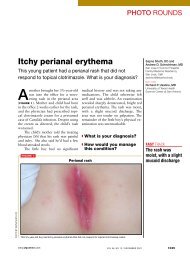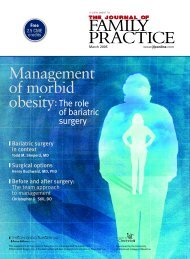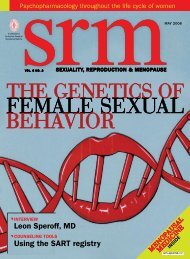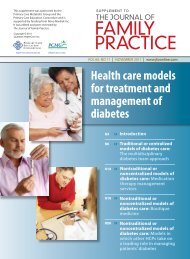Download the PDF - The Journal of Family Practice
Download the PDF - The Journal of Family Practice
Download the PDF - The Journal of Family Practice
You also want an ePaper? Increase the reach of your titles
YUMPU automatically turns print PDFs into web optimized ePapers that Google loves.
JFP_0306_AE_Power.finalREV2 2/21/06 10:40 AM Page 198<br />
APPLIED EVIDENCE<br />
FAST TRACK<br />
TABLE 3<br />
SYMPTOM<br />
1. Passage <strong>of</strong> any flatus when socially undesirable<br />
2. Any incontinence <strong>of</strong> liquid stool<br />
3. Any need to wear a pad because <strong>of</strong> anal symptoms<br />
4. Any incontinence <strong>of</strong> solid stool<br />
5. Any fecal urgency (inability to defer defecation for<br />
more than 5 minutes)<br />
SCALE<br />
Immediately after<br />
repair, consider<br />
giving patients<br />
laxatives and<br />
broad-spectrum<br />
antibiotics, and<br />
possibly refer<br />
for physical<br />
<strong>the</strong>rapy<br />
Fecal Continence Scoring scale<br />
0 Never<br />
1 Rarely (1/day)<br />
A score <strong>of</strong> 0 implies complete continence and a score <strong>of</strong> 20 complete incontinence.<br />
A score <strong>of</strong> 6 has been suggested as a cut-<strong>of</strong>f to determine need for evaluation.<br />
Source: Mahony et al, 2001; 43 modified from Jorge and Wexner, 1993. 44<br />
nique is preferred, and it remains <strong>the</strong><br />
method most <strong>of</strong>ten used by colorectal surgeons<br />
in elective, secondary anal sphincter<br />
repairs. 36,39,42<br />
A Cochrane review <strong>of</strong> which technique<br />
is better has been registered in <strong>the</strong> Clinical<br />
Trials Database. General agreement is that<br />
closure using interrupted sutures <strong>of</strong> a<br />
mon<strong>of</strong>ilament material, such as 2-0 polydioxanone<br />
sulfate (PDS), is <strong>the</strong> preferred<br />
closure method for <strong>the</strong> external sphincter<br />
(SOR: C). 36,40 It is recommended that a<br />
damaged internal sphincter be repaired<br />
with a running continuous suture <strong>of</strong> a<br />
material such as 2-0 polyglactin 910<br />
(Vicryl) (SOR: C). 36<br />
■ Immediate post-repair<br />
management<br />
Use a stool s<strong>of</strong>tener<br />
It had long been thought that constipation<br />
following obstetric anal sphincter injury<br />
allowed <strong>the</strong> sphincter to heal more effectively.<br />
However, new evidence from RCTs<br />
shows that using a laxative instead <strong>of</strong> a constipating<br />
regimen is more helpful in <strong>the</strong><br />
immediate postpartum phase. 43 Toward this<br />
end, use a stool s<strong>of</strong>tener, such as lactulose,<br />
198 VOL 55, NO 3 / MARCH 2006 THE JOURNAL OF FAMILY PRACTICE<br />
for 3 to 10 days postpartum for women<br />
with obstetric anal sphincter injury. 40<br />
Should you prescribe an antibiotic?<br />
Given <strong>the</strong> devastating effects <strong>of</strong> post-repair<br />
infection, most authorities consider it<br />
prudent to prescribe a course <strong>of</strong> broadspectrum<br />
antibiotics, possibly including<br />
metronidazole (SOR: C) 37,40 A Cochrane<br />
review is registered to fur<strong>the</strong>r examine this<br />
issue. A separate Cochrane review <strong>of</strong> <strong>the</strong> use<br />
<strong>of</strong> antibiotics for instrument vaginal delivery<br />
concluded that quality data were insufficient<br />
to make any recommendations. 44<br />
Refer for physical <strong>the</strong>rapy<br />
Some authorities consider an early referral<br />
to physical <strong>the</strong>rapy for pelvic floor exercises<br />
helpful in <strong>the</strong> immediate post-partum<br />
for all patients with obstetric anal sphincter<br />
injury (SOR: C). 45<br />
■ Long-term management<br />
Ask patients about incontinence<br />
Given that some women are too embarrassed<br />
to seek assistance, ask those with<br />
obstetric anal sphincter injury specific<br />
questions about any symptoms <strong>of</strong> anal<br />
incontinence at a follow-up visit, such as<br />
<strong>the</strong> 6-week postpartum visit (SOR: C). 37,40<br />
In some practices, all women who have sustained<br />
a third- or fourth-degree laceration<br />
are routinely scheduled for a 3-month follow-up<br />
visit to a dedicated clinic, irrespective<br />
<strong>of</strong> symptoms. Given <strong>the</strong> prevalence <strong>of</strong><br />
occult obstetric anal sphincter injury for<br />
primigravid women, you may find it best to<br />
survey all women postnatally concerning<br />
any changes in anal continence. TABLE 3<br />
demonstrates a validated, modified<br />
patient survey <strong>of</strong> anal incontinence. 37,40 A<br />
score <strong>of</strong> 6 is <strong>of</strong>ten used as a cut<strong>of</strong>f.<br />
When additional evaluation is needed<br />
Patients who have symptoms <strong>of</strong> altered<br />
continence at 3 months (or who score<br />
above 6 on <strong>the</strong> Wexner scale) should be<br />
seen at a dedicated gynecologic or colorectal<br />
surgery clinic, 46 where <strong>the</strong>y can receive<br />
a more detailed clinical evaluation and









